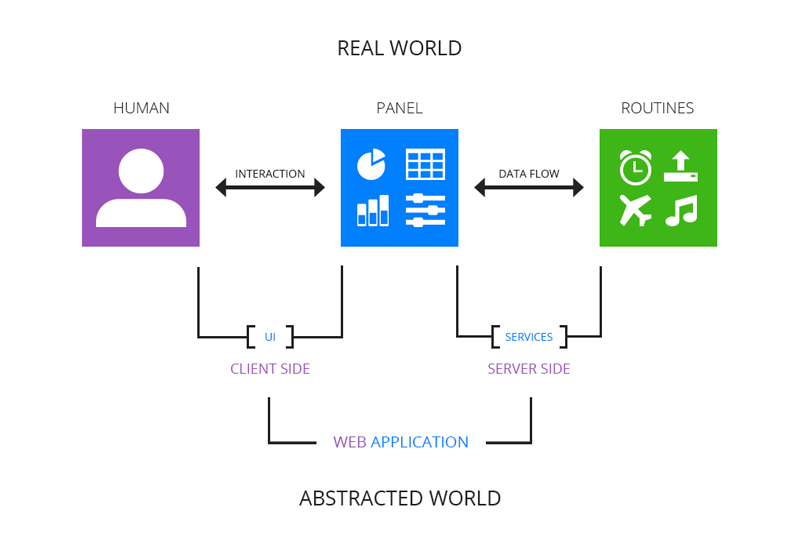Stage.js
Change Log - What's changed?
To get version, type app.stagejs in the console. Example output:
app.stagejs (1.10.x-<commits> build <timestamp>)
You can compare this version number with the one you see on the documentation site and see if an upgrade is recommended.
Announcement: v1 api spec will be published soon with updated doc/demo site. There is also an -ng branch development. A preview is available here at (-ng plan). Please note that v1 will NOT be abandoned even if -ng is released, they are implemented with different tech direction and code organization, but same exposed apis.
*The v1 branch serves as a benchmark for creating tests for features/apis and for feedback gathering. We have now successfully released 6 web/cloud products offering intuitive control panels, complex monitoring dashboards, online/offline reports and excellent user interactions with full localization support. More will come.
This project produces Stage.js - an infrastructure for building modern web application client with different contexts (e.g a data-heavy administration app). In other words, we solve this problem for you:
Quick Start
Use the devtools to get started quickly.
1. Prep
npm -g install stage-devtools
stagejs env
2. Start
mkdir <project dir>
cd <project dir>
stagejs init
stagejs theme
stagejs serve [--port <number>]
You can now start developing your app with Stage.js. Read the command-line devtool for more.
How-to
Again, as an application developer you are encouraged read this documentation
Contribute to framework
Fork/Clone the project and tweak the code locally, then contribute by making a pull request so you can push the change in.
Prepare
After cloning the project, you should go to /tools and run these commands:
0. Check your development environment (yes, you can use our stage-devtools cli in this step)
stagejs env
(you might need to npm install -g bower forever, also install graphicsmagick on system)
1. Prepare npm packages (node.js v4)
npm install
(canvas@1.2.3 will complain No package 'cairo' found, so you need to install libcairo2-dev libjpeg-dev libpango1.0-dev libgif-dev build-essential g++ on system)
2. Prepare bower packages
./lib-prep.sh
3. Prepare doc site theme packs (under ./themeprep)
node run site
4. Fire up dev server (background logging by forever)
./start.sh [profile] [port]
5. Check dev server logs
forever logs
This should fire-up the development server. It will serve the /implementation folder as web root on the port define by /tools/devserver/profile/default. Please go check the content of this profile config file before starting. It has some nice middlewares and auto-change-detectors there you can switch on/off to make the development a lot easier.
Develop, Demo & Test
Change code under /implementation/js/src to contribute your ideas to this framework.
Change the code under /implementation/js/site to test your ideas, it is the application for Stage.js's documentation site and it also holds all the tests and demos.
Look closely at the /implementation/index.html file, it not only defines the loading sequence of all the js files but also defines which one goes to which build profile (framework, site) and bag target (all.js, stage.js) in the build process. /implementation/starter-kit.html goes into the starter-kit build as index.html. There is only 1 html file for loading the js/css files (which is index.html) the reset of *.html are templates and are loaded by the js view objects upon application runtime. This is the way of the single-page applications.
Modify base theme in framework
/implementation/themes/default is the base theme package used whenever developer use stagejs theme <name>. Although it is often not necessary to modify this base theme. You can still improve it if you have a better idea or more UI components added into the framework that need styling.
Follow instructions in the /less/main.less. You can easily switch to use other themes based on Bootstrap 3 or quickly build up your own. (check out themes offered by bootswatch)
You can start a new theme by using the theme-prep tool under /implementation/tools/themeprep. Note that this is the same as using the command-line tool stagejs theme <name> in your own projects. But since this is the framework project itself, the command-line tool can not be of assistance here. Chicken'n'Egg thing.
As in your own projects, themes will be automatically watched and recompiled each time your *.less file changes.
Important: If you see any of the *.less file contains @import url("...") it is better to remove them before you compile the theme. Try to bring that piece to local code base. (e.g Host the web-font yourself)
Note: All @import url("...") lines which contains string fonts will be removed. If you don't know how to bring google webfonts to local, use google-webfonts-helper.
Build everything
0. Change the version numbers
CHANGELOG.md
tools/libprep/bower.json
(README.md, HOWTO.md are updated automatically.)
1. Update libs & bower release version
tools/lib-prep.sh
2. Build framework, starter-kit & doc site
tools/build.sh tag
What's in -ng?
-ng Roadmap:
- Build a lightweight framework core from scratch; (
✔️ ) - Handshake (Full-Async) mode for view init/data/nesting; (
✔️ ) - Remove theming/templating deps on Bootstrap (easy to hook your own); (
✔️ ) - Port custom-made DevOps process pipeline onto Gulp; (
✔️ ) - Optional AMD support; (
✔️ ) - Optional ECMAScript6 (2015-2016) support; (
✔️ ) - Optional reactive view building; (two-way bindings, like MVVM) (
✔️ ) - WebRTC integration for peer-to-peer data/stream sharing; (in progress)
- Give View action listeners a choice to go background (Web Worker) (
✔️ )); - Introduce state machine into Views (app.ee(), (
✔️ )); - Local filter/sort/pagination in Views (v1 has remote version only, (
✔️ ));
License
Copyright 2013 - 2017 Tim Lauv. Under the MIT License.




